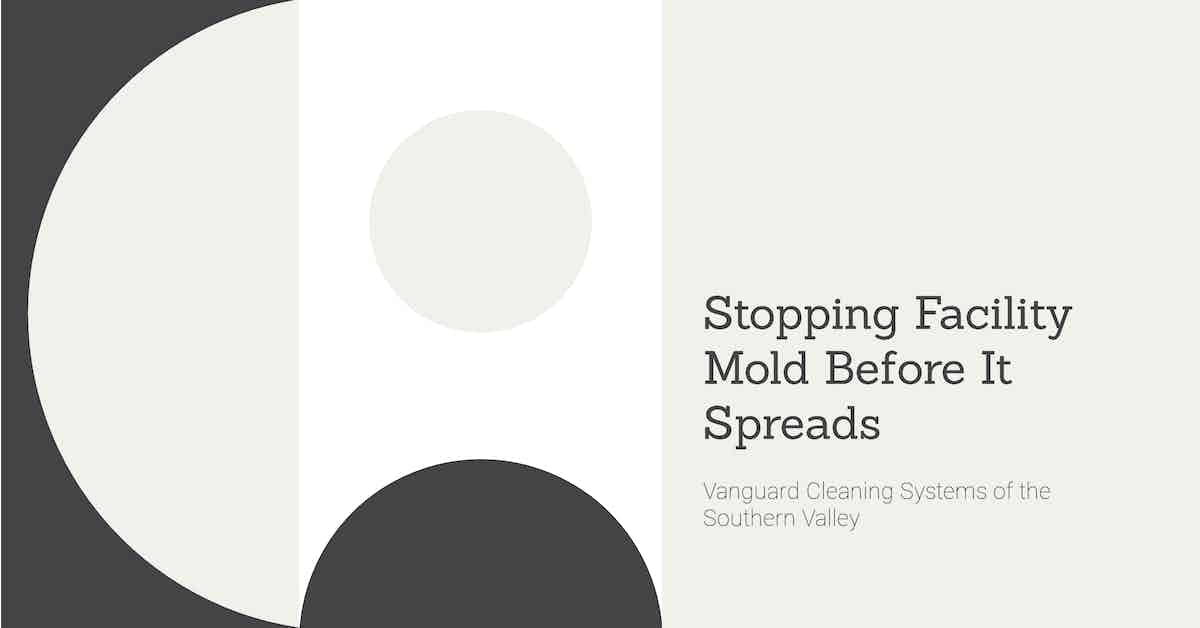Rapid mold growth in facilities is a common issue resulting in expensive damage to the built environment and potentially resulting in severe occupant health issues, OSHA violations, closures, fines, lawsuits, and medical-related costs.

The Dangers of Facility Mold
Mold spores commonly enter facilities through
- Open doors or windows
- Vents
- Poorly filtered HVAC systems
- On the bottom of occupant shoes or on their clothes, and;
- On pets in buildings that allow them.
When mold spores fall on an area with high moisture levels- typically around a leaky pipe, roof, or a recently flooded space- it begins to grow.
Mold rapidly develops on:
- Paper products
- Cardboard
- Ceiling tiles
- Wood products
- Paints
- Wallpaper
- Insulation
- Drywall
- Carpet
- Fabric
- Upholstery
- In dust
In the correct environment, spores develop into colonies that turn into mold within 24-48 hours.
Mold growth will damage the built environment, especially wood, drywall, and ceiling tiles, resulting in inspection, remediation, and repair costs that can easily range well into tens of thousands of dollars per incident.
Additionally, mold exposure negatively impacts occupant health, commonly resulting in:
- Respiratory problems, wheezing, and asthma attacks.
- Nasal and sinus congestion or a dry, hacking cough.
- Eye irritation, burning, watering, and redness.
- Nose or throat irritation, including sneezing fits and bloody noses.
- Skin irritations such as rashes or hives.
- Nervous system issues, including headaches, memory loss, mood changes, and;
- Body aches and pains.
Facility owners are required by both regulations from the Occupational Health and Safety Administration (OSHA) and the U.S. Environmental Protection Agency (EPA) to perform due diligence regarding occupant health and safety.
According to CleanFax;
Due diligence places the onus on employers to ensure workers are not exposed to hazardous conditions that could cause serious harm on the job site, as well as to comply with the safety and health standards set forth in the Act.
This means that, while there may be no direct laws regulating the work in an area, it is still the responsibility of the employer to protect employees or face penalties ($13,653 per serious violation and up to $132,598 per violation in the case of willful or repeated offenses per OSHA).
Due diligence requires a site risk/hazard assessment and the development of an exposure control plan that lays out the appropriate equipment and PPE needed, among other requirements, but it is unfortunately not uncommon for workers to go forward with a project without performing an acceptable risk assessment.
Further, where an occupant or employee falls ill due to facility mold exposure, building owners are subject to:
- Workers' compensation claims.
- Back wages, and;
- Related medical expenses.
Mold Prevention and Cleaning
Preventing mold from taking root is significantly less expensive than remediation and repair.
Routine cleaning will remove mold spores before they can develop into colonies.
- Dust, sweep, vacuum, and mop occupied spaces daily, especially dining areas, bathrooms, and stairwells.
- Use walkway and entry mats to prevent spores from entering the facility on occupant shoes.
- Regularly inspect and repair HVAC systems and moisture-generating appliances and fixtures.
- Install MERV-13 or higher HEPA filters.
In the event of flooding or suspected water leaks:
- Inspect the facility for wet or damp surfaces and leaking infrastructure or pipes--specifically basements, bathrooms, stairwells, and ceilings.
- Repair all leaks immediately.
- Dry water-damaged surfaces with a combination of fans and mechanical or natural ventilation.
- Remove water-damaged materials and dispose of them according to State and Local regulations.
- Clean the damaged area with a commercial-grade soap-based detergent applied with microfiber, then disinfect with a fungicide/anti-mold disinfectant.
If occupants begin to smell musty odors, develop a persistent cough, or notice a discoloration in the ceiling or walls, contact a professional inspector and have them test the air and assess your facility.
References & Resources
- Dealing With Mold and Mildew in Your Flood-Damaged Home
- Basic Facts about Mold and Dampness
- Black Mold in Your Workplace: What You Should Know
- How Much To Repair Mold Damage
- A Brief Guide to Mold in the Workplace
- 47 Mold Statistics: Black Mold Deaths Per Year
Takeaway
Mold is a common issue affecting more than 45M buildings, 70% of homes, and 26% of healthcare facilities in the United States.
Proactive environmental cleaning methods, including high-outcome carpet and floor care--will arrest the introduction and growth of spores into colonies and ensure high levels of indoor air quality and occupant health.
Outsourcing is a proven method for onboarding highly in-demand cleaning and disinfection services and experience for a fraction of the price of maintaining a similar service in-house.
If you would like more information regarding the effectiveness of high-performance infection prevention and control measures, or if you would like to schedule a free, no-obligation on-site assessment of your facility's custodial needs, contact us today for a free quote!
In Bakersfield, CA, call (661) 437-3253
In Fresno, CA, call (559) 206-1059
In Valencia, CA, or Santa Clarita, CA, call (661) 437-3253
In Palmdale, CA, or Lancaster, CA, call (661) 371-4756

